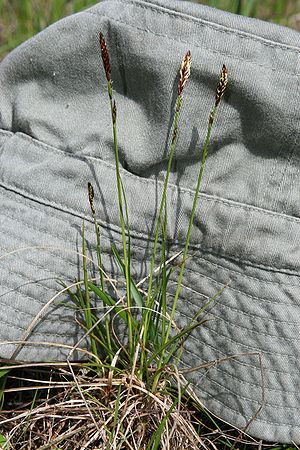Carex inops
Contents
Taxonomy
Kingdom: Plantae
Subkingdom (unranked): Tracheobionta
Superdivision (unranked): Spermatophyta
Division: Magnoliophyta
Class: Liliopsida
Subclass (unranked): Commelinidae
Order: Cyperales
Family: Cyperaceae
Genus: Carex L.
Species: C. inops L.H. Bailey
Description
Long-stolon sedge is a loosely caespitose, perennial graminoid. It is low to medium statured compared to other Carex. Culms are 4 to 20 inches (10-50 cm) long. Leaves are slender, stiff, and wiry. Old, dead leaves are persistent, often forming fibrous tufts at the stem base. Inflorescences are terminal staminate and pistillate spikes. Male spikes may be pediceled above female spikes. The fruit is a hairy achene ranging from 1.6 to 2.5 mm long. Seedheads bear 5 to 15 fruits each.
Bloom Period
Distribution
Found in the northwestern Great Plains of the United States and Canada, ranging from the western Dakotas to Montana and Saskatchewan.
Habitat
Stands are found on gently rolling uplands with little to moderate slope.
Uses
Propagation
Photo Gallery
References
Seed
Abbraviation: CAIN
Seed sample from: 2010
Average measurement: 3.6 x1.6 x 1.3
Measurement Range: L: 2.5 – 4.5, W: 1.2 – 2, D: 1 – 1.9
Features
Shape: Seeds narrow at hilum and opposite apex, rounded in middle. Opposite apex usually sharply pointed. Seed sometimes has bits of husk still attached. Hilum circular.
Color: Tan with some darker brown or black spotting. Hilum usually brown.
Surface: Some concave patches, entire seed covered in fine hair, and matte.


